Learning to ride a horse at a canter is a major milestone for beginner riders as they advance in their riding education.
For many, a horse’s canter can be a hard gait to ride. There’s a lurching transition, an increase in speed, and (for some horses more than others) a canter can feel more like a high-speed wobble than the “rocking horse” motion books use to describe it.
It’s normal to feel a little nervous as you learn to canter, but by learning more about horse’s canters and how to properly ride the gaite, you can become a confident canter rider. In this article, I’ll help! We’ll talk about:
How to cue your horse to canter. Then, I’ll draw on my experience as a riding instructor and share some tips for relaxing as you transition into the canter. Next, I share how sitting correctly in the saddle at the canter can help you feel secure and connected. Finally, you’ll learn how to know if you are ready to canter and the most common canter cues.
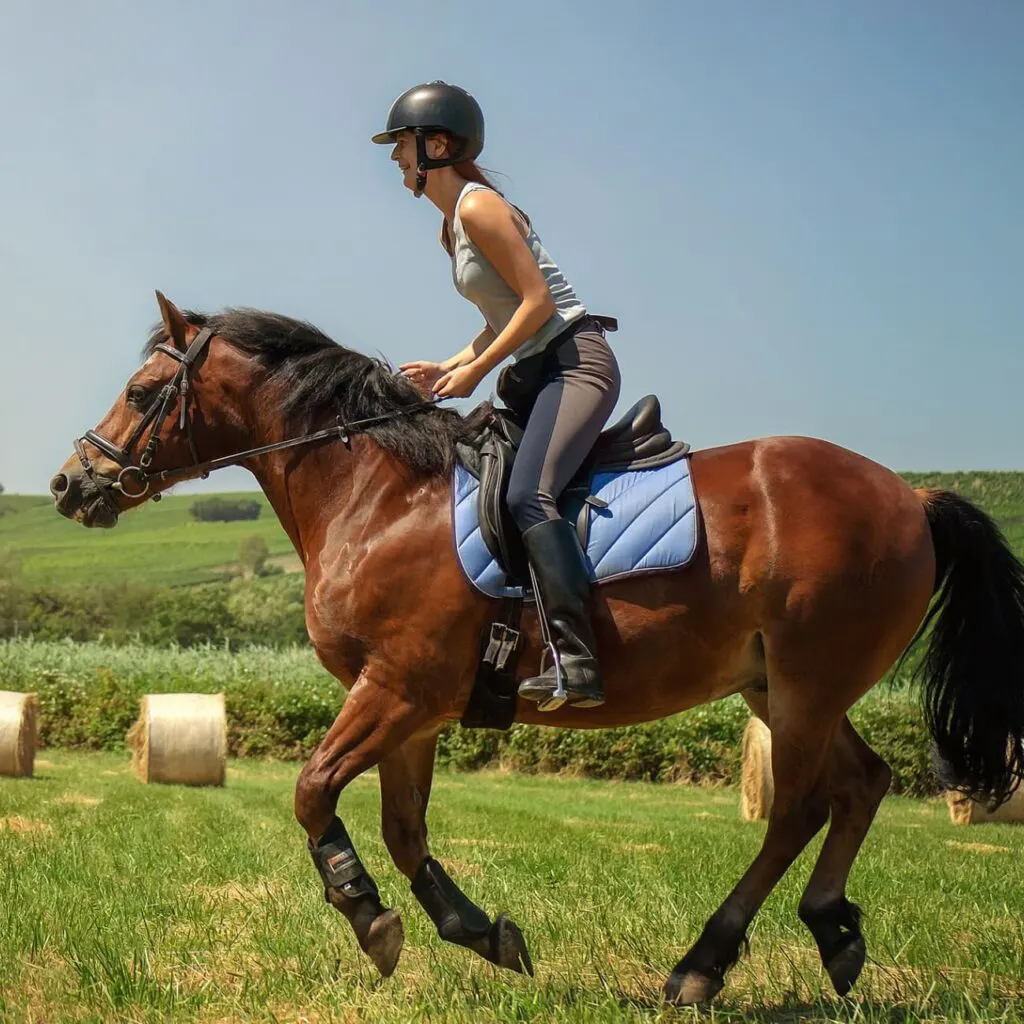
Horse Canter Cues
The most common cue for canter is slipping the outside leg back a few inches and pressing that lower leg into the horse’s barrel (side). This cues the horse to push off with that outside hind leg into the canter.
💡 The “outside leg” is the leg on the outside of the arena circle, if you are riding in a ring. If you are in an open space riding a straight line you can choose one side or the other.
However, cues can vary from horse to horse.
Each horse is different, and each horse is trained by a different person. Many riding disciplines (dressage, western pleasure, games, trail, jumpers, etc) have slightly different ways of cueing for canter- and every horse trainer has a unique take on training for the canter cue. Despite this difference, there is a lot of overlap in these cues for signaling your horse to canter. Learning the canter cue for your horse might take a little experimenting.
For some very well-trained horses, this cue is only meaningful at the correct point in their stride when the outside hind is about to land. However, for most horses applying the outside leg just behind the girth (at any time) is a command for them to strike off into canter at the next stride.
Other common horse canter commands include:
- a slight thrust with the pelvis towards the inside shoulder (given at the same time as the command with your leg)
- Slack on the inside rein at the same time as leg and body cues
- or verbal commands for canter may include:
- a smooch,
- kiss, or
- cluck sound
- possibly, even the word “canter.”
If you’re having trouble locating your horse’s command for canter, you may have to train a new signal.
To train your horse to canter, don’t just ride a faster and faster trot in hopes that your horse will break into a canter. (This is called “chasing a horse into a gait” and it can cause issues with slowing down a horse later).
Instead, work with your horse on a lunge line. Use the lunge line sessions to practice many gait transitions. Swing the end of the lunge line as needed to motivate an upward gait transition. Associate each gait change with a sound (such as a “cluck” for trot, “kiss” for canter, and “whoa” for downward transitions)
After a few sessions, you and your horse will share a new language. Next time you’re in the saddle and want to canter, you can use verbal cues to reinforce your body cues and get a cleaner canter transition.
How to Relax During the Canter Transition
Many new riders have nervousness about how fast a horse’s canter is. Sometimes these worries cause a rider’s body to tense up as the horse begins to canter. The result is often a missed transition, a confused horse moving unpredictably, or even a rider falling.
The canter transition does not have to be tense! Anyone can learn to relax, soften their body, and ride the powerful surge of a canter transition.
Exercises to Grow Confidence Cantering
The best exercise to help a rider relax when asking for a canter is to ride the transition many times on a lunge line. Ask your instructor or an experienced rider to allow you to ride a well-trained horse on a lunge line. In this method, the trainer can control the direction, speed, and gaits of the horse. You can then focus 100% on your seat.
Get extra stability. As you practice canter transitions on your horse, grab a bit of mane or the front of your saddle. On a western saddle you can grab the horn. English riders can add a grab strap (and should, as a matter of safety, in the opinion of this veteran rider). Remember to keep your legs long and heels down. This helps you sit deep in your saddle.
Practice. When the trot to canter transition becomes easier, use loose reins or no reins at all (and no grabbing for mane!) and ride through as many transitions up and down as you can handle.
Experience is the best way to relax and overcome anxiety over the canter transition. Repeating the bumpy and unfamiliar canter transition over and over trains your body how to respond to the movement of the canter. Over time and with practice you will eventually learn to ride the canter.
As you relax, your horse will also relax.
A relaxed horse will pick up the canter more fluidly, and as a result, actually make the canter transition less intimidating to ride.
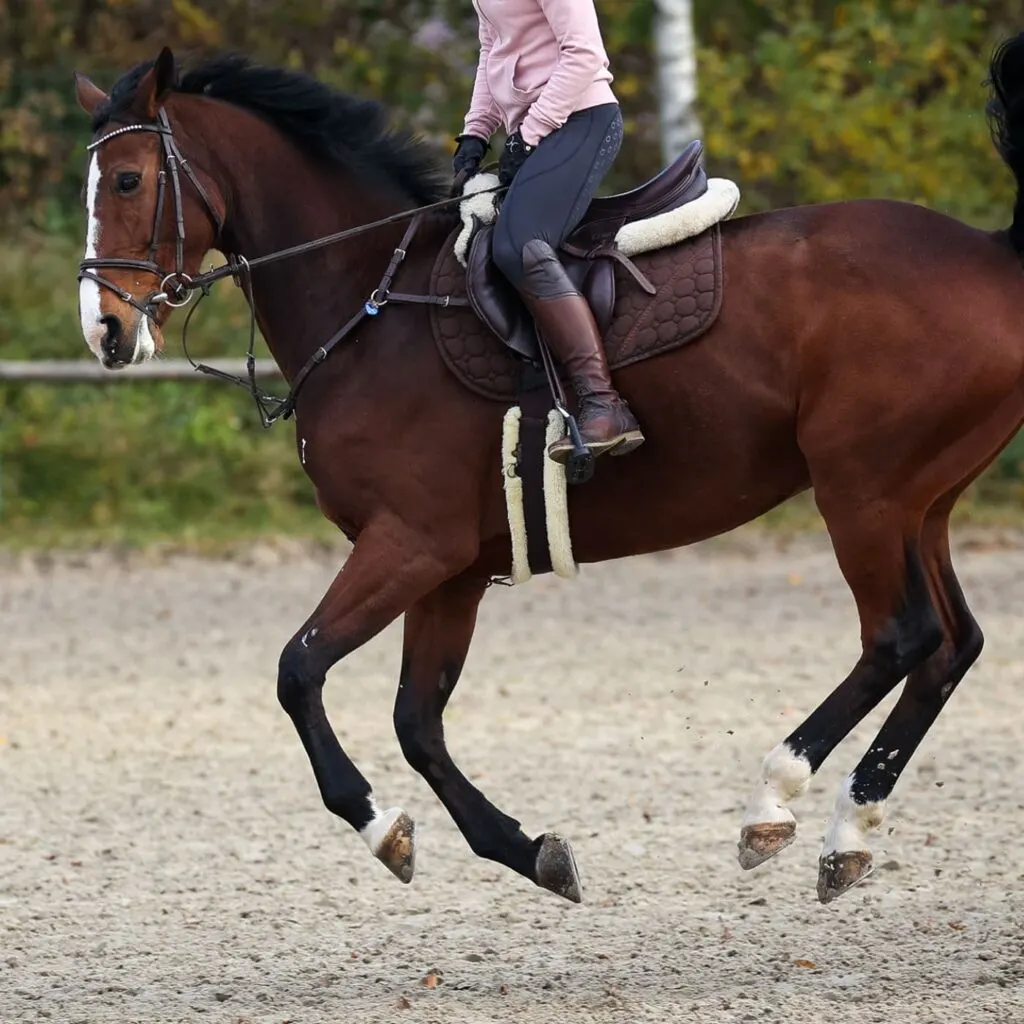
Ready to Canter
Learning to ride the canter on horseback can be intimidating for many beginner riders. However, once the canter is mastered, it often becomes a favorite gait!
It’s easiest to learn to ride the canter with the help of good riding lessons and a patient horse.
You’ll know you are ready to canter when:
- 1. You are comfortable riding, turning, and stopping the walk and trot.
- 2. You are able to match your horse’s stride posting at the trot.
- 3. You are able to walk and trot for short periods with no stirrups.
- 4. You are learning to balance yourself by stretching into, rather than pulling up, your heels.
Don’t rush yourself! Some new riders canter right away, and others need more than a year of practice at slower gaits. In Europe, it’s not unusual for a new rider to only walk and trot for a year or more!
Learn more about how long it takes to ride a horse, and what milestones to aim for.
To help you relax and enjoy your first canter, you may want to ask to canter for the first time on a lunge line. This allows the horse to stay under the control of your instructor so you can focus on your seat.
From trot, take a deep breath, make sure your heels are down, give the cue your instructor tells you to, and allow your hips to swing with the first surging stride of the canter. Try to avoid leaning forward- sitting straight in the saddle will help your seat bones stay deep and secure in the saddle.
If you are in a western saddle you may want to stabilize yourself with a firm grip on the horn the first few times. In an English saddle, you can grasp the mane to add stability, but avoid making these grips a habit.
Don’t be embarrassed if you are scared to canter; the canter is intimidating to many riders. It is ok to learn at your own pace. Your horse will appreciate the time you take to develop a deep, relaxed seat until the day you’re ready to canter.
Correct Canter Position
The correct position for riding a canter can be difficult to pick up right away. However, once a correct position is adopted, sitting and riding the canter becomes significantly easier. Below are a few hints and tips regarding the correct position at the canter.
The secret to riding a canter is to relax – particularly to relax the back muscles used when horseback riding.
- Let your body swing in rhythm with your horse.
- Keep your elbows flexible, letting your hands and reins follow the motion of your horse’s head.
- The correct canter position remains basically the same as a correct position in general: sitting deep, with shoulders back and head up.
Researchers in a 2016 study noted that advanced riders have less movement in their torso at the canter than new riders do.1
Western or English, the rider’s position should remain relaxed and upright. Resist the temptation to lean forward or brace your legs, as this will pull your body out of the saddle when your horse canters. Instead, drape your legs around your horse. Your heel position should create a straight line through your hips, shoulders, and head.
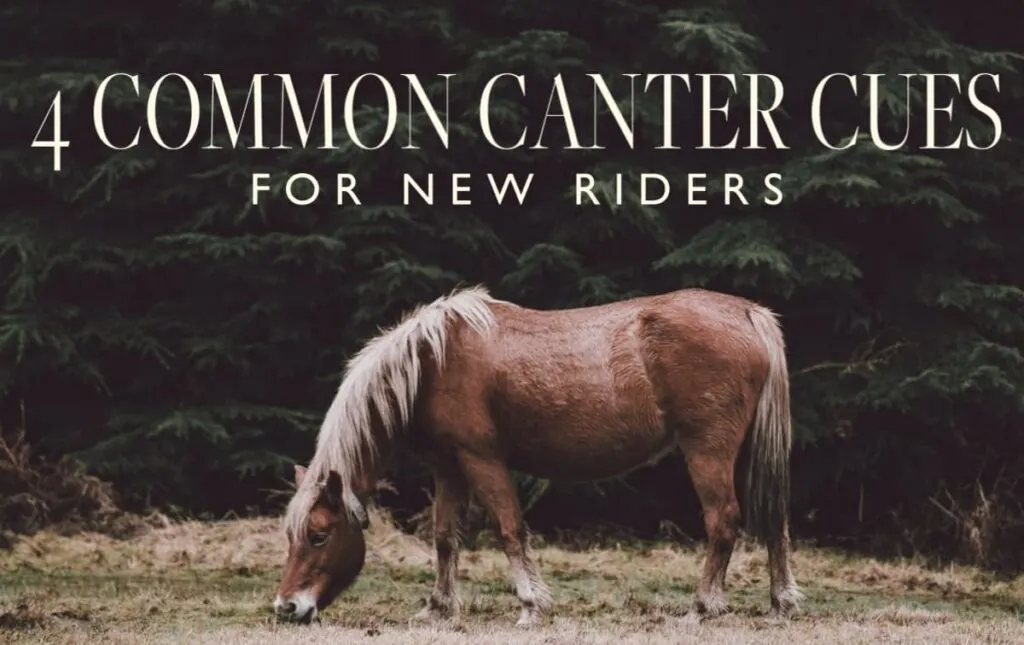
4 Tips for How to Make a Horse Canter
The transition from trot to canter is a bumpy one for most riders to learn. For both horse and rider, it requires more muscle and balance than other gait transitions. Because of this, and the relationship between the two (inexperienced riders tend to be a little bouncy in this transition and may inadvertently cause their horse to take this transition awkwardly or avoid it entirely).
A “canter” is a gait halfway between a gallop and a trot. Called a “lope” in American Western riding, the canter is a rocking gait that, once used to it, is many rider’s favorite gait.
Lots of people want to know how to make a horse canter. Although there are some specific ways to try making a horse canter, all horses are trained a little differently- so there’s no one right answer for how to make a horse canter. What works for one horse may not work for another, so to make your horse canter, try these different methods:
1. Voice cues
Some horses are trained to voice cues. If you are riding an unfamiliar horse, try kissing, clucking, or smooching. Hold on, because some very well-trained horses will automatically leap into a canter at the sound of their cue!
2. Use your body
One other way to make a horse transition into a canter is by using your body to give the signal.
This is the most natural method for a horse, and when executed correctly the horse will slip into a very smooth transition that is comfortable for horse and rider. To begin, as you are riding at a comfortable trot, slide your outside leg back behind the girth (the outside leg is the leg on the outside of the arena, if you are not riding in an arena or other natural circle, bend your horse to one direction just slightly before you give the cue as this will help them balance their body through the transition).
Press your outside leg against the side of your horse just behind the girth. If you are coordinated enough, at the same time relax your grip on the inside rein and slide your inside hip forward in the saddle. If you time this motion right- this subtle movement is so strong to the horse that they cannot help but take the next stride in a canter! Many riders can benefit from doing a hip-opening mounted stretch before working on canter transitions.
3. Use a prop
If your horse is reluctant to canter or purposely avoids it, try laying a pole in the middle of your riding area. Ride your horse up to the pole at a trot, and ride forward over the pole. Many horses will naturally make a small jump and take the next few strides at a canter.
If you follow the horse and ride the canter well and encourage your horse to stay in the gait, they should remain at a canter. Be very careful, as horses who have not jumped over polls before may act unpredictably, including stopping dead in their tracks which can unseat a rider. You may wish to lunge your horse over the polls a few times without a rider first, so they understand how to hold their own body over the pole before navigating it with the rider.
If the pole on the ground doesn’t work, and you are an experienced rider with safety equipment, you may try raising the pole off the ground by a few inches. (Never attempt a real jump without proper safety equipment and instruction!) Be sure to reward your horse with your hands and voice when he does canter. Make sure when he strides into the canter (it could be bumpy!) not to yank on the reins. Holding onto a big handful of your horse’s mane may help steady your hands to prevent this.
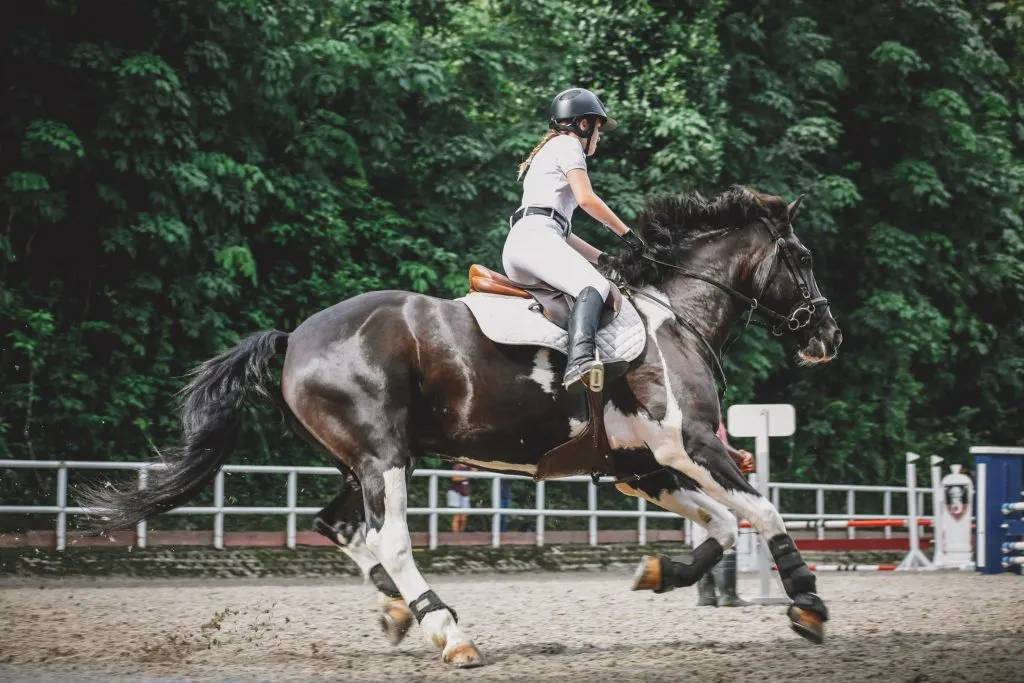
4. External motivation
You may also, gently, use a whip to make your horse canter. Safe riding crops are designed to “pop” without causing actual pain. Make sure it is a short whip that is just long enough to swat your horse’s rump to remind him to be motivated to canter. Be aware of transition aided by the use of a crop, especially the first time, may be very bumpy!
If used fairly and correctly, a whip can be a good tool to help backup your natural aids to help make a horse canter. You may only need to actually use the crop a few times; my favorite show horse had the gaits of a plodding old cart horse until you picked up a short crop from the ringside. He knew just the presence of the crop meant my cues had backup! This resulted in a happy, forward gait and balanced transitions without ever having to lift the crop!
- Eckardt, F., & Witte, K. (2016). Kinematic analysis of the rider according to different skill levels in sitting trot and canter. Journal of Equine Veterinary Science, 39, 51-57. [↩]

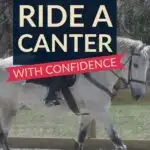

Mona
Thursday 8th of August 2019
The leg pressures should be all the time on or just on and off? I am still a bit confused When to give pressure with inside leg and when with outside leg.
Thanks.